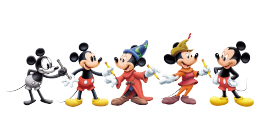In 1930, Roy Williams started his career at The Walt Disney Studios as an artist. He later became a storyman, until, after the advent of television, Walt Disney personally cast the “300 pounds of walking pixie” in a new role. As Roy later recalled, “Walt was in my office when suddenly, he looked up at me and said, ‘Say, you’re fat and funny looking. I’m going to put you on the Mickey Mouse Club and call you the Big Mooseketeer!’” Roy, with his impish grin, became an instant favorite with children around the world.
Born on July 30, 1907, in Colville, Washington, Roy grew up in Los Angeles. While attending Fremont High School, he learned to make people laugh with the outrageous cartoons he sketched. After high school he was offered a sports scholarship to the University of Southern California, but instead applied for a job at the up-and-coming Walt Disney Studios—and was personally hired by Walt.
During those early years, Roy worked on nearly all of the animated shorts produced by the Studio; at the same time, he attended evening classes at Chouinard Art Institute. He moved to the story department after presenting a Donald Duck gag to Walt. In the gag, Donald swallowed a magnet and attracted every metal object imaginable. Walt was so impressed with Roy’s unbridled imagination that he tripled his salary.
Roy E. Disney, former vice chairman of The Walt Disney Company, once recalled, “Roy was amazing. You’d ask him for gags for a situation and he’d give you literally hundreds of them.”
As a story man, Roy contributed to such animated films as Saludos Amigos, The Three Caballeros, and Make Mine Music, while, as an artist, he contributed to the Silly Symphonies The Night Before Christmas, The China Shop, and many others. During World War II, he designed more than 100 insignias for the armed forces, including the award-winning Flying Tigers insignia.
Roy is best known, however, for the four seasons he played “Big Roy” on the Mickey Mouse Club. He is also credited with designing the trademark ears worn by the show’s cast. His fun-loving nature and immense talent made him a perfect publicity representative for the company. On numerous occasions, Roy traveled across the country to promote the re-release of such films as Cinderella; in 1959, he served as goodwill ambassador for The Walt Disney Studios. Later, he worked as a Disney comic strip artist, cartoonist at Disneyland, and consultant on the traveling arena show “Disney on Parade.”
Roy Williams passed away on November 7, 1976, in Burbank, California.



